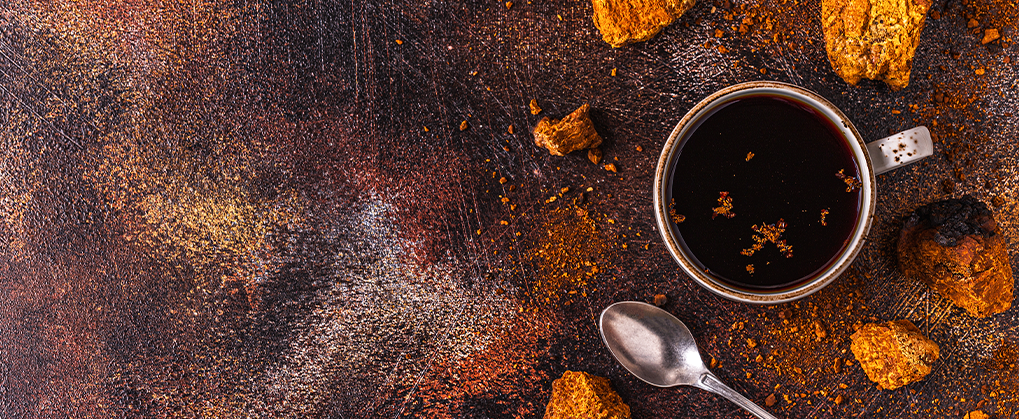DOES CHAGA HAVE SIDE EFFECTS?


Chaga is a popular medicinal mushroom that has been used in natural medicine for many centuries: for a strong immune system, for inflammations, skin problems and much more. You can read about all the health benefits of Chaga here.
Chaga is considered well-tolerated and is experiencing a real hype as a superfood.
However, as with almost all remedies, treatments and medicines, one should always be aware of possible side effects or interactions with natural food supplements.
So users ask themselves: can the vital mushroom Chaga cause side effects? And we also asked: are there any bad experiences with Chaga?
Quality and origin of Chaga
First of all, it is essential to look for good quality Chaga. Because freshly harvested from the tree is always something different than powder, teas or imports.
Bad experiences with Chaga often occur with imports from China, where the medicinal mushroom is artificially cultivated and processed on huge mushroom farms.
Pesticides are often used, so that the actual vital substances are missing, but toxins can be contained in the active ingredient.
It does not have much in common with the naturally grown and carefully harvested wild Chaga mushroom from the north. Chaga grows naturally on birch trees in Finland, Siberia or Mongolia, and it is best to buy Inonotus obliquus.
But here too, harvesting, processing, drying and use are necessary for optimal Chaga quality.
Attention with allergies
Chaga is traditionally used as a remedy for particular allergies, but only under medical supervision.
People with allergies, especially to birch pollen or mushrooms, should not take Chaga, as (natural) Chaga mushrooms grow mainly on birch trees and are collected there.
Application
The correct preparation and application as well as the Chaga dosage are immensely important. Freshly collected Chaga chunks can be ordered on the internet, but the Chaga mushroom sometimes has hard and poorly digestible components. Preparation as a tea or as a powder dissolved in liquids is therefore essential to reap the health benefits of Chaga.
Possible Chaga mushroom side effects:
> Gastrointestinal problems
> Abdominal pain
> Constipation
> Diarrhoea
> Allergies (especially to mushrooms or birch pollen)
> Kidney stones (especially with Chaga overdose)
If you experience side effects after taking Chaga, this may be a sign that you:
> you have taken too high a dose of Chaga,
> the Chaga product is contaminated with harmful substances (heavy metals or pesticides),
> Chaga has not been properly harvested, stored or prepared, or
> an allergy is present (can be medically tested).
Chaga should taste earthy or woody but not bitter, as this may indicate possible mould spores. In case of doubt: stop taking it and consult doctors. In case of strong and persistent Chaga side effects or indisposition: stop taking it and consult a doctor.
How can one prevent side effects of Chaga?
Slight gastrointestinal disturbances at the beginning of taking Chaga are basically normal. After all, it is a natural product to which every person reacts somewhat differently. Chaga tea is best tolerated, if necessary also made from powder, and is particularly effective when drunk on an empty stomach.
To prevent side effects of Chaga or bad experiences with Chaga, you can follow some simple tips:
> Do not exceed the recommended dose of Chaga (prolonged intake of too much Chaga could damage the kidneys due to the oxalic acid it contains).
> Start with a small dose and increase slowly
> Follow the instructions for use and intake recommendations of the respective manufacturers.
> Chaga capsules or pure powder are more difficult to digest, Chaga powder in liquids or as tea or as an infusion of Chaga chunks is easier for the stomach to process.
> Chaga as a tea is very digestible and should have almost no side effects.
Origin and quality of Chaga
As always, when you want to buy medicines or nootropics, the same applies to the superfood Chaga: the quality is important so that you do not have a bad experience with Chaga.
It varies considerably depending on whether the medicinal mushroom was able to grow on birch trees for many years or was artificially cultivated. High-quality of Chaga powder or chunks can be expected from Northern Europe (Scandinavia), the Baltic States or Siberia, preferably harvested by hand from wild birch forests. They should have grown there for at least five years. Chaga mushrooms must dry well in order to be processed as Chaga powder, if necessary, so that no moulds can form. The type of packaging is also important.
Criteria to avoid bad Chaga experiences:
> Country of origin
> Age of the mushroom
> Tree species and location
> Type of the respective Chaga mushroom: Inonotus obliquus
> Buy pure Chaga powder without additives
> Good drying and storage
> Packaging
Does Chaga have any interactions?
Chaga is not yet known to interact with food or certain medicines. People with pre-existing conditions should discuss the intake of food supplements, including Chaga, with their doctors.
Although Chaga is supposed to strengthen the immune system, patients with autoimmune diseases are patients with an autoimmune disease are often not allowed to take remedies that strengthen or support the immune system. The same applies to the simultaneous use of antibiotics - in case of doubt, all medications, nootropics and remedies that are used at the same time should therefore be medically clarified in advance.
Sources:
https://utopia.de/ratgeber/chaga-pilz-wirkung-und-anwendung-des-finnischen-waldpilzes/
https://de.wikipedia.org/wiki/Schiefer_Schillerporling
https://youoptimized.co/magazin/chaga-pilz/
https://www.supplementbibel.de/chaga-pilz-test/
https://www.chaga-pilz.org/chaga-pilz-nebenwirkungen/
Text author:
Kay Svegler
Communications, PR, American Studies, University of Leipzig
Journalist and freelance writer (e.g. Süddeutsche Zeitung, BILD, MDR etc.)
Former Senior PR Manager for Fischer Appelt, Sustainability and Diversity Manager for DKB





_front%20(1)-250x250.png)



_front%20(1)-250x250.png)

-(NN)_front%20(1)-min-250x250.png)

_front%20(1)-250x250.png)


_front%20(1)-min-250x250.png)
_front%20(1)%20(1)-250x250.png)
_front%20(1)%20(1)-250x250.png)
_front%20(1)-min-250x250.png)
_front%20(1)-min-250x250.png)
_front%20(1)%20(1)-250x250.png)
_front%20(1)%20(1)-250x250.png)



